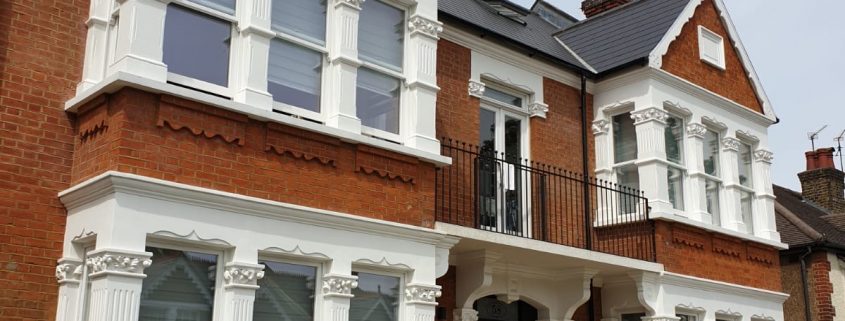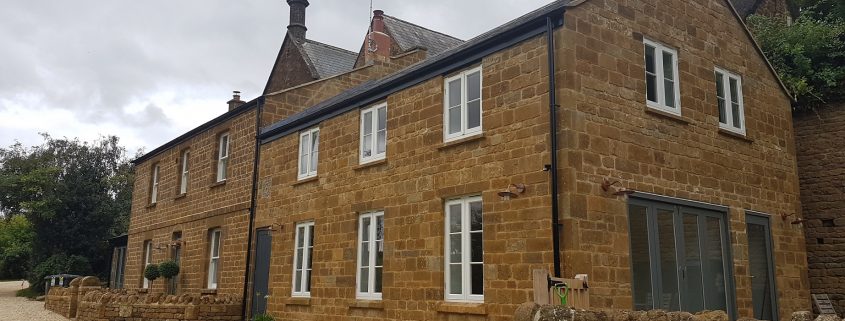Timber Window Glossary
Antique Glass – Generally refers to the process of flat glass production using the traditional mouth-blown method. The sheets produced are of modest size but are large enough for most restoration works.
Casement Window – Generic name for a window that has openers which are hung on hinges, at the side – usually metal or timber frames.
Cathedral or Rolled Glass – “Cathedral” is a rolled glass and started to be commercially available in 1830’s. Produced by pouring molten glass onto a metal or graphite table and immediately rolling it into a sheet using a large metal cylinder. The rolling can be done by hand or machine and can produce a very wide variety of colours and surface textures including hammered, rippled, seedy, and marine textures.
Chamfered – The edges have been removed lengthwise at an angle.
Crown Glass – Crown glass was an early type of window glass and relatively primitive. It was formed by twirling a sphere of molten glass into a disc. At the centre of the crown glass, a thick remnant of the original blown glass would remain, hence the name “bullseye.” First made in 1674, and until 1830’s.
Dovetail – A type of joint. One piece has a splayed shape – like a dove’s tail – and fits into the socket or eye of the second piece.
Doweling – Cylindrical piece or length of wood. Also known as rounded wood.
Drip groove – A groove cut or
moulded in the underside of a door or window sill to prevent rainwater running
back to the wall.
End grain – The exposed face of timber produced when it’s cut through a plane that’s perpendicular to the grain.
End-jointed – See glossary
entry fan-jointed.
Engineered wood – Layers of hardwood compressed together, as with our excellent Engineered Redwood timber option.
Fanlights – A fanlight is a window with glazing bars that is placed over another window or doorway, that opens like a fan, and is sometimes hinged to a transom.
Fascia board – A strip of wood that covers the ends of rafters and to which external guttering is fixed.
Finger-jointed – Also called
end-jointed. Shorter pieces of wood are joined to create a longer piece of
wood. The joint looks like interlaced fingers.
Fixed – Whether
describing a door or a window, then the word fixed refers to it being non
operable.
Float Glass – A modern & standard technique since 1959, molten glass is poured onto molten tin to create an even, smooth and uniform finish.
Glazing Bars (also called Georgian Bars or Astragal) – Originally glazing bars of both sash and casement windows were abundant and thick. On the inside they were moulded to refract light and reduce glare. On the outside they were rebated to hold a glass pane (with traditional wooden or metal frames).
Hardwood – Timber produced from broad-leaved trees.
Head – The top
horizontal member of a wooden frame.
Head plate – The top
horizontal member of a stud partition.
Horns – Small spurs of timber that project on a Sash Window – hanging down from the top sash and up from the bottom sash in some instances). Horns were introduced in the 19th Century to strengthen the joints.
Jamb – The vertical side member of a door or window frame.
Muff, Cylinder or Broad Glass – Preceded Crown glass and was made by blowing a cylinder of molten glass, which was then cut along its side and flattened in a furnace, leading to seeds and bubbles.
Mullion – Vertical bar or pier made of masonry or timber that separate opening casements and/or “fixed” lights to cater for larger windows.
Ovolo – Is a rounded convex moulding
Preservative treatment – The treatment of timber with chemicals to improve its resistance to attack by biological organisms, such as fungi, insects and marine borers. The chemicals can be brushed or sprayed onto the surface of the timber but treatment is more effective if the chemicals are impregnated into the timber under vacuum and/or pressure in special treatment vessels.
Rebate – A rectangular recess along the edge of a timber [frame] designed to receive a shutter, door or window.
Reveal – The vertical side of an opening in a wall.
Sanded – Smooth surfaced – smoother than a planed surface.
Shake – Wood that’s split to reveal its natural texture.
Shingle – Wood sawn
lengthwise that’s thicker at one end – the butt – and thinner at the other end
– the tip.
Short grain – When the general
direction of wood fibres lies across a narrow section of timber.
Sill – The lowest
horizontal member of a stud partition or the lowest horizontal member of a door
or window frame.
Soffit – The underside of
a part of a building such as the eaves or archway.
Softwood – This is usually obtained from pine, fir, spruce or larch. Most structural timber used in the UK is softwood.
Staff bead – The innermost
strip of timber holding a sliding sash in a window frame.
Stile – A vertical side
member of a door or window sash.
Stopper – A wood filler
which matches the colour of the timber.
Strength grade – The strength of
timber varies with the species and is also affected by characteristics like
knots, slope of grain and splits. Each piece of timber used structurally has to
be strength graded, either by visual inspection or by machine. The timber is
marked with its grade and other information such as its species, whether the
timber was graded wet or dry, the company responsible for the grading and the
certification body responsible for overseeing the grading operation.
Sap – Liquid – mostly water – contained within cells in a tree or timber. Sap is the means by which dissolved food and salts are moved around the tree.
Sash – In the first sash windows produced the top sash was fixed and the bottom sash slid upwards in a groove, held open in position by means of pegs or metal catches. In the late 17th Century a variant was introduced as we are familiar with today – the ‘double hung’ sliding sash window, with both upper and lower sashes hung on cords and counter-balanced by hidden weight.
Stained Glass – Traditionally this is glass that has had a stain applied to the surface and permanently fused with the glass by firing in a kiln. Panels constructed in the same way as traditional leaded lights.
Stay – A horizontal length of metal bar affixed to an opening casement and that attaches to the window frame to hold open.
Transom – A horizontal bar dividing a window into two or more “lights”.
Toplight – A window above another window or door (see glossary entry fanlight)
U -Value – The u-value is a measure of how easily heat can pass through the materials that make the door or window








